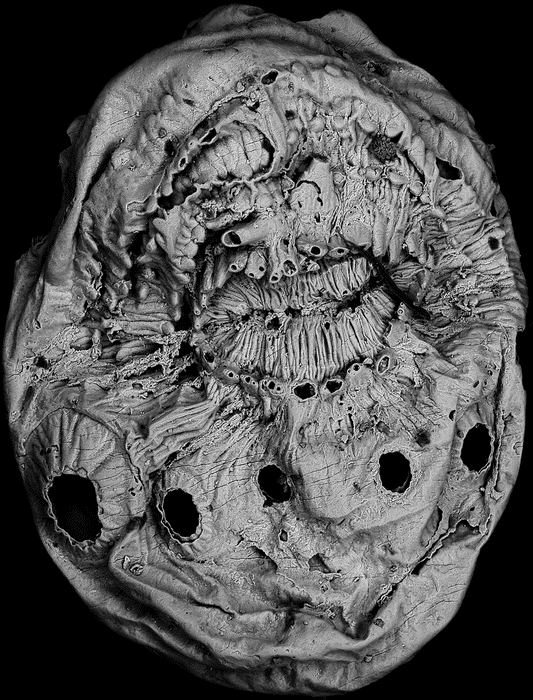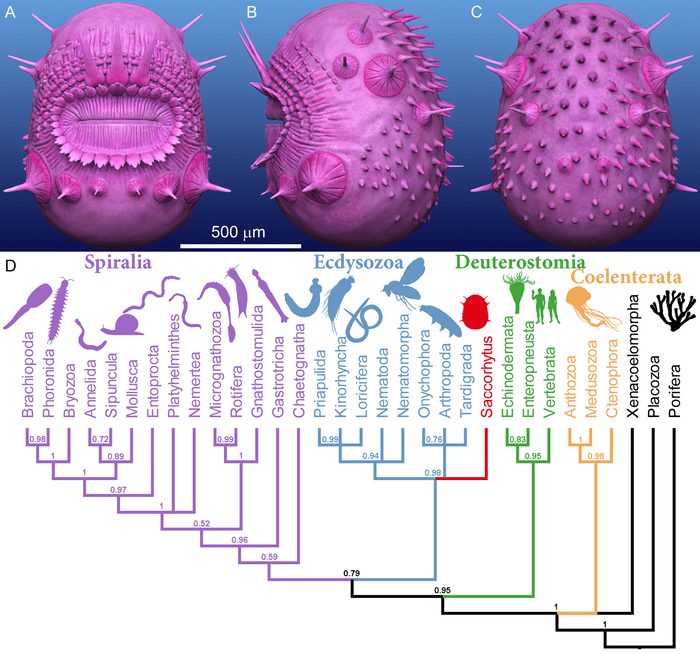In every family tree, there’s someone you’d prefer not to acknowledge. For many paleobiologists that has been Saccorhytus, an extinct microbe that looked like a talking cactus. What made it particularly embarrassing was that its giant mouth had no counterpart at the rear end. The only thing worse than an arsehole in the family is the absence of one.
Fortunately, however, we need acknowledge this anus-less beastie no more, as it is now officially someone else’s problem. It turns out we and Saccorhytus are not related, or at least no more so than any other terrestrial life forms.
The news is so joyous it has been announced in Nature, and comes as a result of an abundance of new specimens measuring 1 millimeter (0.04 inches) across being found in China’s Shaanxi Province.
“Some of the fossils are so perfectly preserved that they look almost alive,” said Professor Yunhuan Liu of Chang’an University, Xi’an. Fortunately, both for our brains and the creatures they might prey on, Saccorhytus has actually been dead for 530 million years.
The reason it was thought we might need to make space for Saccorhytus at the family reunion, lay in the tiny holes around the angry-looking mouths of fossilized specimens. These, palaeontologists thought, were tiny gills, placing their owners in the deuterostomes, the clade of animals whose mouth only forms after its anus during embryonic development.
That, in case you didn’t know, includes us and all other vertebrates along with starfish and some worms. It does seem an odd place to put a creature without an anus, but gills would have been powerful evidence. Being a deuterostome wouldn’t have necessarily made Saccorhytus our direct ancestor, but it would certainly imply a strong connection, particularly since it would have been the oldest deuterostome we have found.
However, co-author PhD Emily Carlisle at the University of Bristol noted: “Fossils can be quite difficult to interpret and Saccorhytus is no exception. We had to use a synchrotron, a type of particle accelerator, as the basis for our analysis of the fossils.”

A scanning electron microscopic image of the Saccorhytus from the Swiss Light Source using synchrotron X-Rays. Image credit: Shuhai Xiao
The images taken with the intense X-Ray light the synchrotron produces were used to construct 3D models of the fossils. Based on these Liu, Carlisle, and co-authors concluded the apparent holes were in fact closed by another body layer and represented the base of spines that had been broken off, rather than gills. The spines are thought to have been used by Saccorhytus to capture prey, although their deterrent potential to predators is apparent.
In the light of this and other evidence from the reconstructions, the authors class Saccorhytus as a protostome (ie mouth forms first). More specifically, they think it is an ecdysoszoan, whose modern representatives include insects, crustaceans, and nematode worms, none of whose representatives are likely to argue the toss.
More worried about making the family tree right than respectable, co-lead author Professor Shuhai Xiao of Virgina Tech wants to find the real first deuterostome. “We are back to square one in the search for the earliest animal with a secondary mouth,” Xiao said in a statement. “The next oldest [suspected] deuterostome fossil is nearly 20 million years younger.”

Artistic reconstructions and phylogenetic position of Saccorhytus coronarius. A, anterior view; B, left view; C, posterior view; D, Where the paper now places Saccorhytus with its previous spot immediately to the right. Image Credit: NIGPAS
On the other hand, no previously hidden anus was revealed by the harsh light of the X-Rays. Since it is unlikely Saccorhytus stored their waste internally until they died, the most likely explanation seems to be that everything unused came back out the way it went in. An approach now most common on Saturday nights on a nightclub strip.
It might be thought that Saccorhytus simply had the misfortune to evolve before some bright spark invented the advanced technology of an anus. However, Xiao refuted that. “This is a really unexpected result because the arthropod group have a through-gut, extending from mouth to anus. Saccorhytus’s membership of the group indicates that it has regressed in evolutionary terms, dispensing with the anus its ancestors would have inherited.”
Yup, the insects can definitely have ‘em.
Source Link: Thankfully, This Creature Without An Anus Is Not Our Earliest Known Ancestor